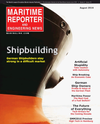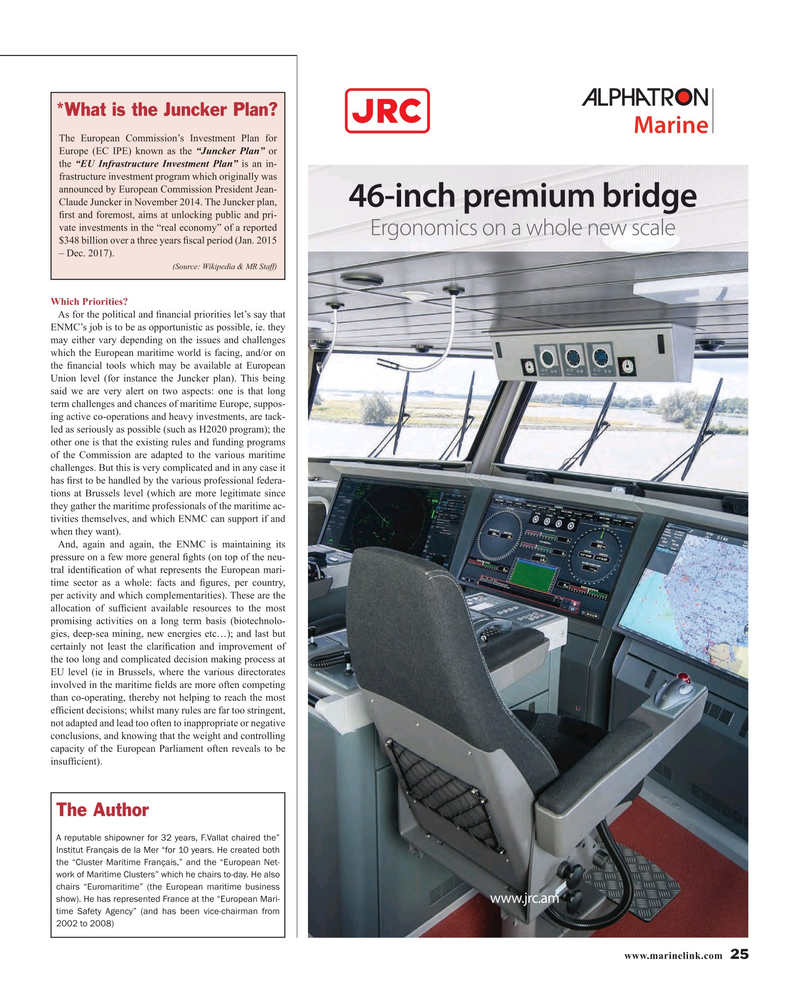
Page 25: of Maritime Reporter Magazine (August 2016)
The Shipyard Edition
Read this page in Pdf, Flash or Html5 edition of August 2016 Maritime Reporter Magazine
*What is the Juncker Plan?
The European Commission’s Investment Plan for
Europe (EC IPE) known as the “Juncker Plan” or the “EU Infrastructure Investment Plan” is an in- frastructure investment program which originally was announced by European Commission President Jean-
Claude Juncker in November 2014. The Juncker plan, 46-inch premium bridge ? rst and foremost, aims at unlocking public and pri- vate investments in the “real economy” of a reported
Ergonomics on a whole new scale $348 billion over a three years ? scal period (Jan. 2015 – Dec. 2017). (Source: Wikipedia & MR Staff)
Which Priorities?
As for the political and ? nancial priorities let’s say that
ENMC’s job is to be as opportunistic as possible, ie. they may either vary depending on the issues and challenges which the European maritime world is facing, and/or on the ? nancial tools which may be available at European
Union level (for instance the Juncker plan). This being said we are very alert on two aspects: one is that long term challenges and chances of maritime Europe, suppos- ing active co-operations and heavy investments, are tack- led as seriously as possible (such as H2020 program); the other one is that the existing rules and funding programs of the Commission are adapted to the various maritime challenges. But this is very complicated and in any case it has ? rst to be handled by the various professional federa- tions at Brussels level (which are more legitimate since they gather the maritime professionals of the maritime ac- tivities themselves, and which ENMC can support if and when they want).
And, again and again, the ENMC is maintaining its pressure on a few more general ? ghts (on top of the neu- tral identi? cation of what represents the European mari- time sector as a whole: facts and ? gures, per country, per activity and which complementarities). These are the allocation of suf? cient available resources to the most promising activities on a long term basis (biotechnolo- gies, deep-sea mining, new energies etc…); and last but certainly not least the clari? cation and improvement of the too long and complicated decision making process at
EU level (ie in Brussels, where the various directorates involved in the maritime ? elds are more often competing than co-operating, thereby not helping to reach the most ef? cient decisions; whilst many rules are far too stringent, not adapted and lead too often to inappropriate or negative conclusions, and knowing that the weight and controlling capacity of the European Parliament often reveals to be insuf? cient).
The Author
A reputable shipowner for 32 years, F.Vallat chaired the”
Institut Français de la Mer “for 10 years. He created both the “Cluster Maritime Français,” and the “European Net- work of Maritime Clusters” which he chairs to-day. He also chairs “Euromaritime” (the European maritime business show). He has represented France at the “European Mari- www.jrc.am time Safety Agency” (and has been vice-chairman from 2002 to 2008) www.marinelink.com 25
MR #8 (18-25).indd 25 8/1/2016 2:14:24 PM

 24
24

 26
26
